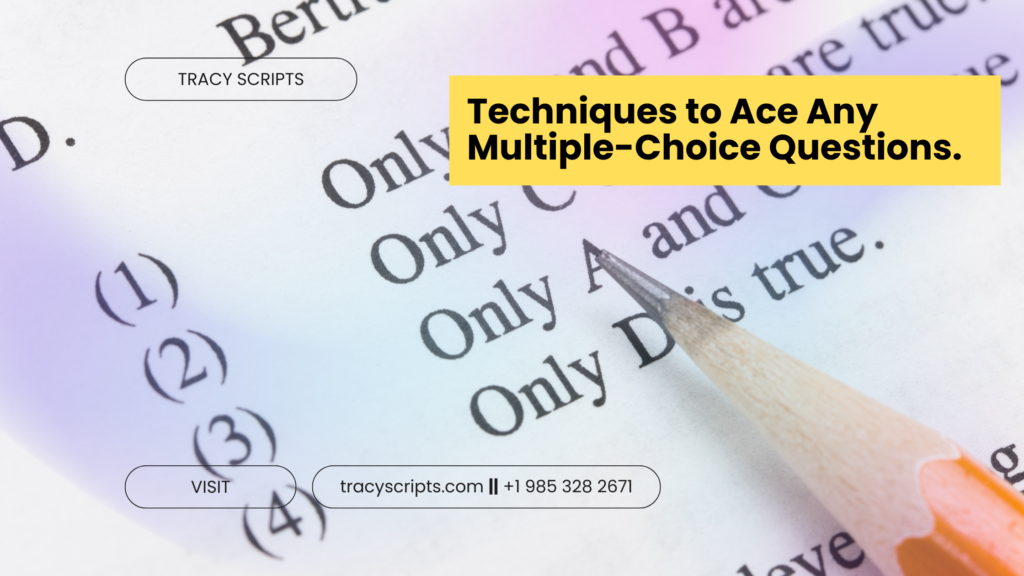Multiple-choice questions (MCQs) are a staple in exams across various fields, from academic tests to professional certifications. On the surface, they seem straightforward—just pick the correct answer. But excelling at MCQs requires a strategic approach to decipher tricky options, manage time, and maximize accuracy. This comprehensive guide will delve into the art of answering multiple-choice questions, equipping you with proven techniques and insights to enhance your performance.
1. Understand the Anatomy of a Multiple-Choice Question
Before diving into strategies, it’s essential to understand the structure of an MCQ. Each question typically consists of three parts:
a. The Stem
This is the main part of the question that sets the context. It may present a statement, problem, or scenario requiring a solution.
Example:
“What is the capital of France?”
b. The Correct Answer (Key)
The correct option is the one that answers the stem accurately.
Example:
- A. Madrid
- B. Paris
- C. Rome
c. The Distractors
These are the incorrect options designed to mislead or test your understanding. They often include common misconceptions or partially correct answers.
Example:
- A. Madrid (distractor)
- B. Paris (key)
- C. Rome (distractor)
Understanding these components helps you analyze questions more effectively.
2. Read the Question Carefully
Common Mistake: Misinterpreting the Question
One of the most frequent errors is skimming the stem and missing crucial details like keywords or qualifiers such as “not,” “except,” or “always.”
How to Avoid This Pitfall
- Underline Key Words: Look for words that define the question’s intent, such as “best,” “primary,” or “most likely.”
- Rephrase the Question: Paraphrase the stem in your own words to ensure you understand it.
- Watch for Negatives: Pay special attention to negative qualifiers like “not” or “none.” These can completely change the question’s meaning.
Example: “Which of the following is NOT a function of the liver?”
3. Answer the Question Before Reading the Options

Why This Works
By predicting the answer in your mind before reviewing the choices, you reduce the risk of being swayed by distractors. This approach ensures that your understanding of the stem remains intact.
How to Apply It
- After reading the stem, pause to think about the answer.
- Compare your mental answer to the options provided.
This technique is particularly useful for factual or definition-based questions.
4. Eliminate Obvious Distractors
What Are Distractors?
Distractors are incorrect answers that seem plausible but are ultimately incorrect.
How to Spot and Eliminate Them
- Overly Broad or Extreme Language: Options containing words like “always,” “never,” or “only” are often incorrect because they leave no room for exceptions.
- Illogical Answers: Remove choices that are clearly irrelevant or illogical in the context of the stem.
- Similar Options: If two options are nearly identical, one is likely correct, and the other is a distractor. Focus on subtle differences.
5. Use the Process of Elimination (POE)
When unsure about the correct answer, the process of elimination can narrow down your choices, increasing the probability of guessing correctly.
How to Apply POE
- Step 1: Cross out options that you know are incorrect.
- Step 2: Focus your attention on the remaining choices.
- Step 3: Revisit the stem and compare it to the narrowed options to make an informed decision.
6. Analyze “All of the Above” and “None of the Above” Options
These options often confuse test-takers, but they follow predictable patterns:

When “All of the Above” is Correct
- If two or more options are correct, there’s a high likelihood that “All of the Above” is the right answer.
When “None of the Above” is Correct
- Only choose “None of the Above” if you are confident that all listed options are incorrect.
7. Beware of Absolutes and Qualifiers
Absolutes
Words like “always,” “never,” and “must” often indicate incorrect answers, as they leave no room for exceptions.
Example:
- A. The sun always rises in the west.
- B. The sun rises in the east.
Qualifiers
Words like “sometimes,” “often,” or “generally” are more likely to appear in correct answers because they accommodate nuances.
8. Manage Your Time Effectively
Common Pitfall: Spending Too Much Time on One Question
It’s easy to get stuck on a challenging question, but this can lead to insufficient time for the rest of the test.
Time Management Strategies
- Set a Pace: Divide the total exam time by the number of questions to determine how much time you can spend on each.
- Skip and Return: If a question stumps you, move on and revisit it later. Mark it for review if the test format allows.
- Prioritize Easy Questions: Answer the questions you’re confident about first to secure easy marks.
9. Guess Strategically When Necessary
Why Guessing Matters
Most exams do not penalize for wrong answers, so leaving a question blank is a missed opportunity.
How to Guess Strategically
- Eliminate Wrong Options: Use the process of elimination to narrow down choices.
- Look for Patterns: If one option appears frequently across multiple questions, it may indicate a correct answer.
- Trust Your Gut: If you’re truly unsure, go with your first instinct—research shows it’s often correct.
10. Review Your Answers Carefully
Why Review Matters
Errors often occur due to misreading questions, skipping parts of the test, or making hasty decisions.
Tips for Effective Reviewing
- Check Instructions Again: Ensure you’ve followed all guidelines, such as answering all required questions.
- Look for Inconsistencies: Verify that your answers match the question requirements.
- Don’t Overthink: While reviewing, avoid changing answers unless you’re certain of a mistake.
Bonus Tip: Practice Makes Perfect
Familiarity with MCQs through practice exams can significantly improve your performance. Regular exposure to similar question formats builds confidence and sharpens your analytical skills.
How to Practice Effectively
- Simulate Exam Conditions: Take practice tests under timed conditions.
- Analyze Mistakes: Review incorrect answers to understand where you went wrong.
- Use Question Banks: Explore a variety of question types to build adaptability.
FAQs About Answering Multiple-Choice Questions
1. What Should I do if Two Answers Seem Correct?
Focus on the nuances of the question and compare both options to the stem. Look for qualifiers or specific language that makes one option more accurate.
2. Should I Always Choose “All of the Above” When Unsure?
Not necessarily. Only choose “All of the Above” if at least two options are clearly correct.
3. How Can I Improve My Guessing Accuracy?
Practice elimination techniques and trust your intuition after narrowing down the options.
4. What if I Run Out of Time?
Quickly scan unanswered questions and make educated guesses. Avoid leaving any blanks.
5. Are Longer Options More Likely to be Correct?
Sometimes. Longer options often include more detail and are more likely to account for nuances, but don’t rely solely on this pattern.
Conclusion: Mastering the Art of MCQs
Answering multiple-choice questions effectively is both an art and a science. By understanding question structure, employing strategic techniques like elimination and time management, and practicing consistently, you can significantly enhance your performance. Remember, success in MCQs isn’t just about knowing the content—it’s about navigating the question format intelligently. With these strategies, you’ll be well-prepared to tackle any multiple-choice exam confidently.
============================================
Get LIFETIME ACCESS to “My Private Prompt Library”: https://buymeacoffee.com/mtspromptslibrary/e/236177
By-pass All Content Detectors (Guaranteed Results): https://stealthwriter.ai/?linkId=lp_731486&sourceId=muhammad-talha&tenantId=stealthwriter
Looking for a custom GPT? Or SEO services for your website? Book Consultation with me: https://bit.ly/4bgdMGc

